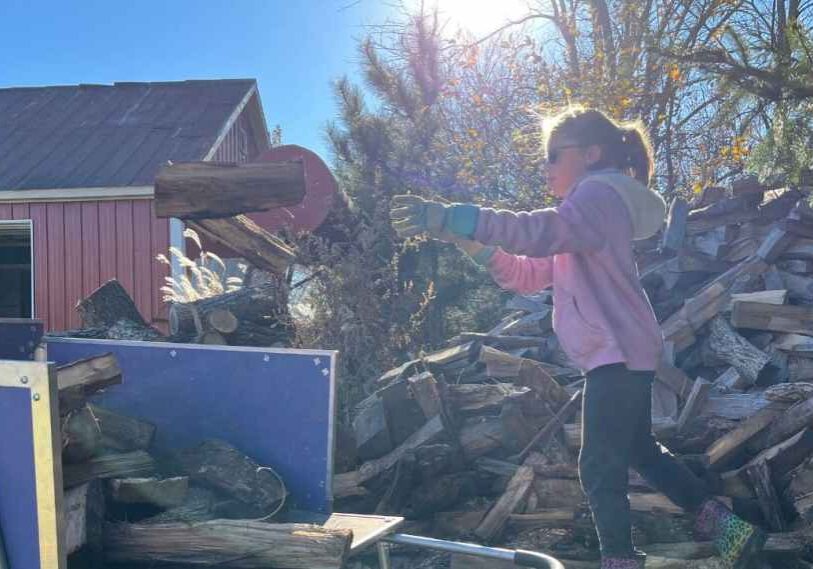Essay | Time is Illusive on Our Farm in the Big Woods

AMHERST TOWNSHIP, FILLMORE COUNTY—Ten years ago, we discovered our home in the Big Woods. Ten years into the future looks like a distant, sometimes unimaginable dream. But peering backwards, it seems half as long.
Time is illusive.
My wife, Jenica, and I found our home almost by accident. A new job, a timely lead from the new boss, and a phone call to the owner all in fast succession opened the gate. Sometimes life’s biggest decisions are the easiest ones—as it was when we concluded happiness could be found by making our home in the Big Woods.
We moved in on Memorial Day weekend. The property had been rented out the couple of years’ prior, and so naturally, the exterior grounds had suffered some neglect. Saplings had overtaken the garden. The fruit trees needed extraordinary pruning. Racoons leisurely marauded the raspberry patch without consequence, making an intolerable mess of the canes.
Box elders were quickly winning the fight against the cattle panel fence. Weeds aplenty filled every space the lawn mower didn’t graze. Projects abounded. Even for a planner like me, it was too overwhelming and proved impossible to make a proper to-do list.
Those first weekends required a significant amount of hand-to-hand combat as we hustled to reclaim the garden and get our first “crop” in the ground. My parents selflessly joined the fight.
Eager as we were to have our own dirt, we jumped the gun and started some seeds prior to moving in. It felt unfathomable to squander the opportunity to grow some food, finally having the black dirt and life stability necessary to plant and harvest a crop after years of being students, renters, and nomadic wanderers. As rookies are apt to do, we started too many. One red currant tomato plant is more than sufficient per household. Six proved ridiculously excessive.
Critters
After clearing and planting the garden, the second order of business was to stock the place with animals. Our barn felt lonely without a resident cat. A housecat made the move with us, however, having lived a life of indoor privilege my wife didn’t have the heart to turn her out. Plus, she didn’t have any front claws. Privileged and defenseless.
We imported a pair of calico kittens from my uncle’s dairy farm. He held their mother in high esteem as a good mouser. I trusted those kittens had been taking notes. Count me as a believer that cats truly do get nine lives. They are still here.
The raccoons that became accustomed to feasting on the local, undefended bounty during years’ prior, may as well have been the welcoming party. I learned to sleep with one ear open—waiting for the all-too-familiar grunts or shaking of fruit tree branches out in the yard. I would jolt out of bed and into the nighttime darkness to scare them away.
Our little farm was a fruit oasis in the middle of the big forest. We were sitting vulnerable and exposed without a guard dog to defend the boundaries.
A foster dog of the Australian Shepherd variety would soon thereafter join us, but quickly proved unsuited to the task. She innocently snuck through the dog door each evening to nestle in the back mudroom rather than face the nighttime boogie monsters.

The Australian Shepherd and Chihuahua like laying in the sun more than chasing critters away from the farm. (Photo by Greg Schieber)
The miniature-pinscher Chihuahua that became our accidental farm dog and made the move with us wasn’t any help, either.
It wasn’t until eight years later when we finally got smart and added our Great Pyrenees, Ruby, to the homestead that I could finally rest easy at night (in between the spontaneous bouts of fierce, protective barking). Choose your poison, I guess.
Some inquiries at the local feed mill tipped me off to a flock of chickens available for the taking. We were too busy planting and cultivating garden produce we’d never have a chance to eat or preserve to think ahead and order chicks.
I borrowed a couple of crates and hauled home a baker’s dozen of heritage varieties I cannot now recall. We haven’t purchased eggs from the grocery store since.
A pair of pregnant Scottish Highlanders cows would come next. The breed, as previously written about, was touted to be docile. As rookies, we turned them out to pasture to discover the exception to that rule. And that, as they say, is a story for another time.
The projects have shifted focus since that first summer. I thought I’d have this place operating on autopilot by now, but the goal posts keep moving. Reclamation is complete. The maintenance is ongoing. Improvements are now intentionally choreographed on a seasonal project to-do list. The pace is becoming less hectic. What’s more, now we have a few little “helpers” afoot, that sometimes really do start to pull a little of their own weight.
Passing this simple milestone naturally makes me wonder what life in the Big Woods will be like for us ten years into the future. Our “helpers” will all be teenagers.
Will they be more, or less, help than they are now? What hobbies will they have added to the farm? Will I tire of hauling home chicken feed?
Will I ultimately raise the white flag and bless my wife’s persistent requests to bring home some goats?
Will I finally get time to relax on the front porch on a Friday evening, or wake up on a Saturday morning and spend the first hour after sunrise sipping coffee wondering what I’m going to do for the day?
That last one seems improbable in the next ten years, but I’ll keep imagining the possibility.

Root River Current’s coverage of the arts is made possible, in part, by the voters of Minnesota through a grant from the Southeastern Minnesota Arts Council thanks to a legislative appropriation from the arts & cultural heritage fund.






